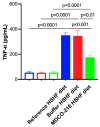Effective Treatment of Diabetic Cardiomyopathy and Heart Failure with Reconstituted HDL (Milano) in Mice
- PMID: 30871282
- PMCID: PMC6470758
- DOI: 10.3390/ijms20061273
Effective Treatment of Diabetic Cardiomyopathy and Heart Failure with Reconstituted HDL (Milano) in Mice
Abstract
The risk of heart failure (HF) is prominently increased in patients with type 2 diabetes mellitus. The objectives of this study were to establish a murine model of diabetic cardiomyopathy induced by feeding a high-sugar/high-fat (HSHF) diet and to evaluate the effect of reconstituted HDLMilano administration on established HF in this model. The HSHF diet was initiated at the age of 12 weeks and continued for 16 weeks. To investigate the effect of reconstituted HDLMilano on HF, eight intraperitoneal administrations of MDCO-216 (100 mg/kg protein concentration) or of an identical volume of control buffer were executed with a 48-h interval starting at the age of 28 weeks. The HSHF diet-induced obesity, hyperinsulinemia, and type 2 diabetes mellitus. Diabetic cardiomyopathy was present in HSHF diet mice as evidenced by cardiac hypertrophy, increased interstitial and perivascular fibrosis, and decreased myocardial capillary density. Pressure-volume loop analysis indicated the presence of both systolic and diastolic dysfunction and of decreased cardiac output in HSHF diet mice. Treatment with MDCO-216 reversed pathological remodelling and cardiac dysfunction and normalized wet lung weight, indicating effective treatment of HF. No effect of control buffer injection was observed. In conclusion, reconstituted HDLMilano reverses HF in type 2 diabetic mice.
Keywords: diabetic cardiomyopathy; obesity; type 2 diabetes mellitus.
Conflict of interest statement
The authors declare no conflict of interest. Herman Kempen was an employee of The Medicines Company (Schweiz) GmbH between 2011 and 2015 and retired subsequently. He does not benefit in any financial manner from being a co-author on this paper. None of the other authors received any financial support of The Medicines Company.
Figures








References
-
- Authors/Task Force Members. Ryden L., Grant P.J., Anker S.D., Berne C., Cosentino F., Danchin N., Deaton C., Escaned J., Hammes H.P., et al. ESC Guidelines on diabetes, pre-diabetes, and cardiovascular diseases developed in collaboration with the EASD: the Task Force on diabetes, pre-diabetes, and cardiovascular diseases of the European Society of Cardiology (ESC) and developed in collaboration with the European Association for the Study of Diabetes (EASD) Eur. Heart J. 2013;34:3035–3087. doi: 10.1093/eurheartj/eht108. - DOI - PubMed
MeSH terms
Substances
Grants and funding
LinkOut - more resources
Full Text Sources
Medical
Research Materials
Miscellaneous

